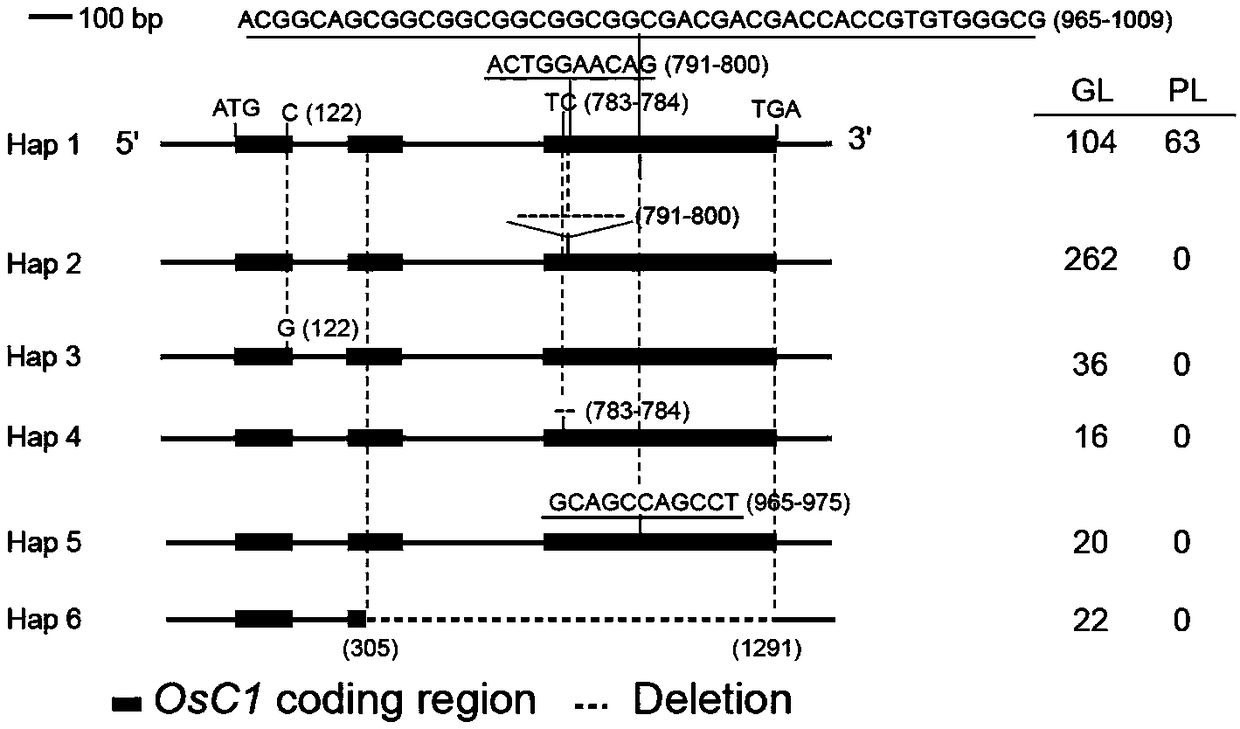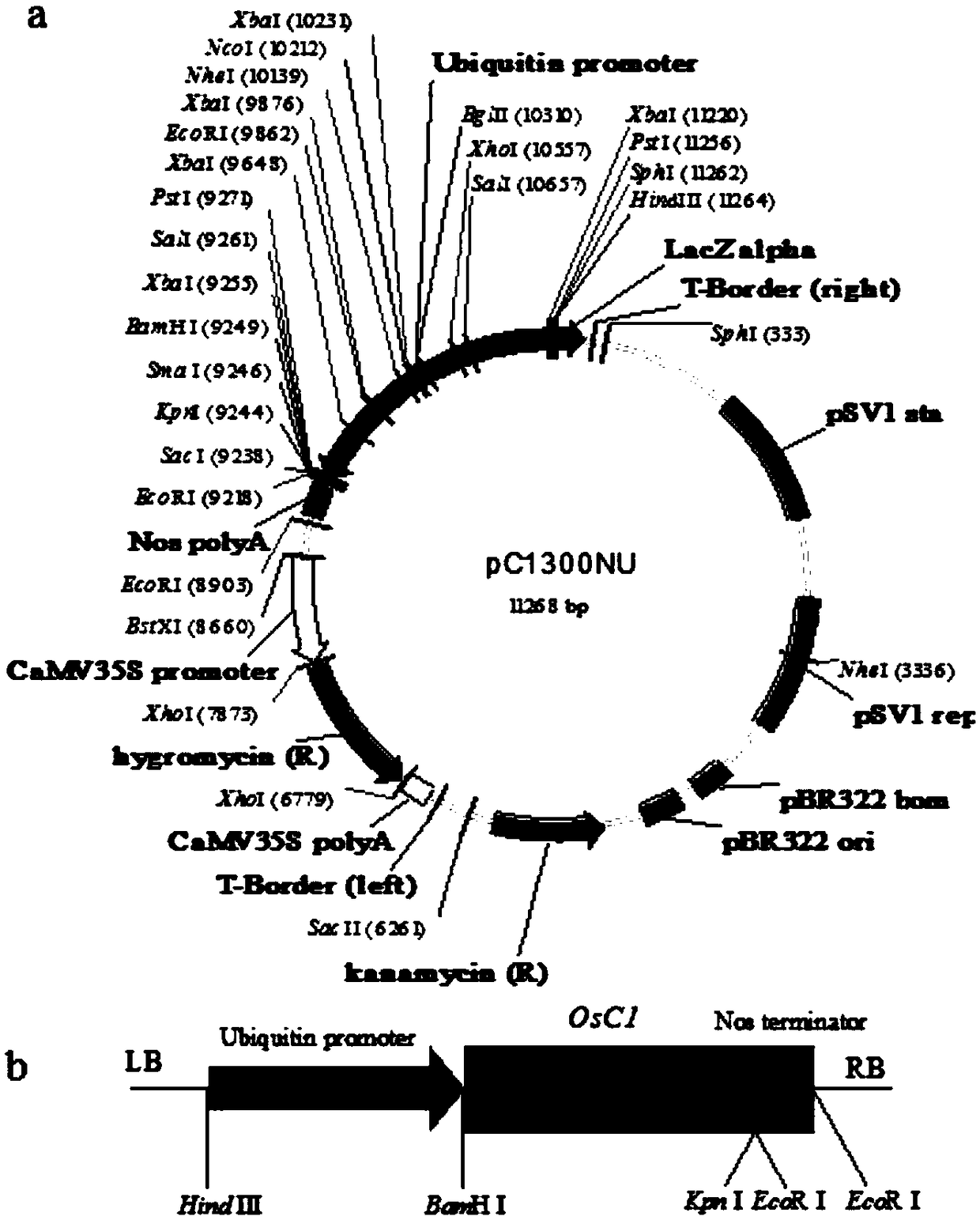Non-functional OsC1 gene and application thereof
A gene and function technology, applied to the non-functional OsC1 gene and its application fields, can solve the problems affecting crop yield and photosynthetic efficiency, and achieve the effect of shortening the breeding cycle and easy operation
- Summary
- Abstract
- Description
- Claims
- Application Information
AI Technical Summary
Problems solved by technology
Method used
Image
Examples
Embodiment 1
[0055] Using GWAS technology to determine the determinants of rice leaf anthocyanin synthesis:
[0056] In the present invention, 533 rice germplasm resources collected from all over the world are planted in the experimental fields on the campus of Huazhong Agricultural University. For specific germplasm resources information, refer to the literature published by Chen et al. (2014) (Chen, W., Gao, Y., Xie, W., Gong, L., Lu, K., Wang, W., Li, Y., Liu, X., Zhang, H., Dong, H., et al. (2014). Genome-wide association analyzes provide genetic and biochemical insights into natural variation in rice metabolism. Nat. Genet. 46:714-721). Leaf samples were collected during the tillering stage of rice. The content of anthocyanins in leaves was analyzed by high-performance liquid chromatography (HPLC). The extraction and determination methods of anthocyanins from rice leaves refer to the literature published by Zhu et al. (2010). The leaf samples were freeze-dried using a vacuum freeze...
Embodiment 2
[0062] Effect test of anthocyanin content in leaves on photosynthetic rate:
[0063] The seedling leaves of the black rice variety "Heishai" were taken, and RNA was extracted with TransZol Reagent. Take 2 μg of Heishuai RNA sample and perform reverse transcription with MLV reverse transcriptase. The obtained cDNA was diluted to 100 μL. Take 1 μL of cDNA as a template, and use OsC1-F (SEQ ID No. 6: GGATCCGCTCAGTCCACACCGCACAGA) and OsC1-R (SEQ ID No. 7: GGTACCGTCACGCACACAAGTTC) to amplify the full-length cDNA sequence of the OsC1 gene.
[0064] The PCR reaction system is:
[0065]
[0066]
[0067] The PCR reaction procedure is:
[0068]
[0069] The full-length cDNA of the OsC1 gene amplified by PCR was cloned into the T vector pEASY-BluntZero (full gold). The expression vector pC1300NU was cut with BamH I and Kpn I ( image 3 a) and the full-length cDNA of OsC1 cloned on the pEASY-Blunt Zero vector, and then the full-length cDNA of OsC1 was connected to the pC130...
Embodiment 3
[0094] Tissue-specific verification of OsC1 gene and anthocyanin synthesis:
[0095] The present invention has collected 51 black rice varieties altogether, wherein 6 varieties come from 533 rice germplasm resources for GWAS analysis, 44 varieties come from China Rice Research Institute, and 1 variety comes from Shaanxi Rice Research Institute (Table 1). 51 black rice varieties were planted in the field, and leaf samples were collected until the tillering stage, and the anthocyanin content in the leaf samples was analyzed by HPLC. The analysis method was referred to Example 1; after maturity, the seeds were harvested, dried, and shelled The content of anthocyanins in brown rice was analyzed by HPLC, and the analysis method was the same as the determination of anthocyanins in leaves. Utilize primers seqOsC1-F and seqOsC1-R to isolate the OsC1 gene sequence of the black rice variety, and the PCR reaction system and amplification conditions are the same as in Example 1. Through...
PUM
 Login to View More
Login to View More Abstract
Description
Claims
Application Information
 Login to View More
Login to View More - R&D
- Intellectual Property
- Life Sciences
- Materials
- Tech Scout
- Unparalleled Data Quality
- Higher Quality Content
- 60% Fewer Hallucinations
Browse by: Latest US Patents, China's latest patents, Technical Efficacy Thesaurus, Application Domain, Technology Topic, Popular Technical Reports.
© 2025 PatSnap. All rights reserved.Legal|Privacy policy|Modern Slavery Act Transparency Statement|Sitemap|About US| Contact US: help@patsnap.com



